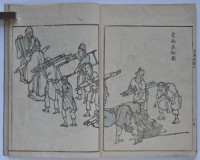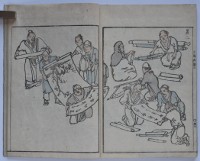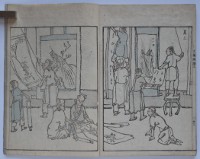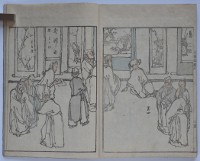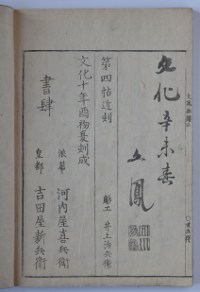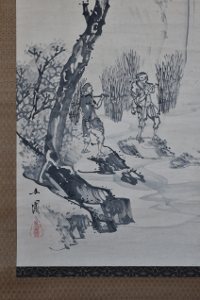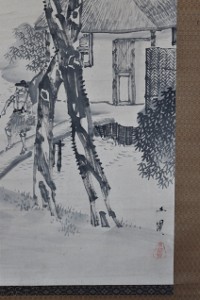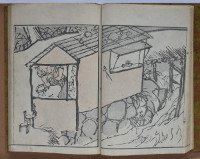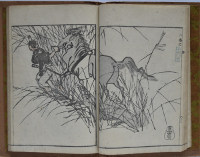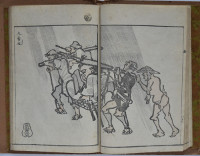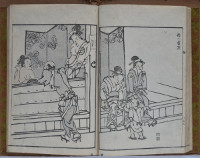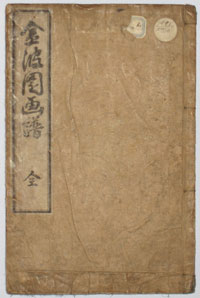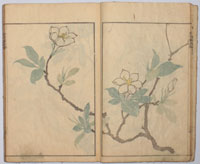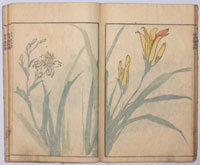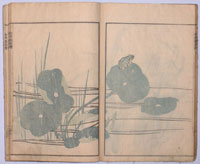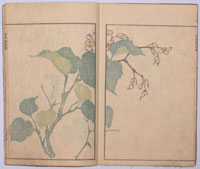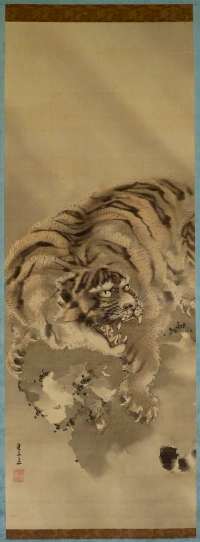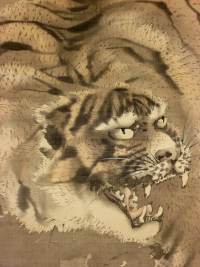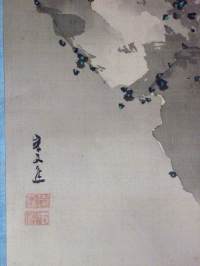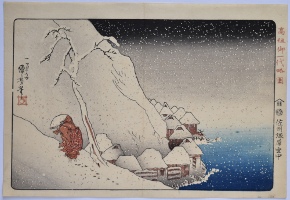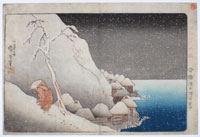Kawamura BUMPO (1779-1821)
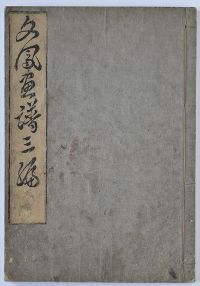
Click here to view image full size.
I volume complete Bumpo gafu (Sampen), “Album of Drawings by Bumpo” (3rd Series”). Original light grey covers with burnished pattern. Original title slip. Preface 3 pp., with 18 double-page and 32 single-page illustrations in sumi and light colour numbered 1 – 35. Colophon dated Bunka 10 (1813).(First edition.) Signed Bumpo with publishers Kawachiya Kihei and Yoshidaya Shimbei. Fine impressions. Very good condition with no thumbing to corners.
Status: Available
Kawamura BUMPO (1779-1821)
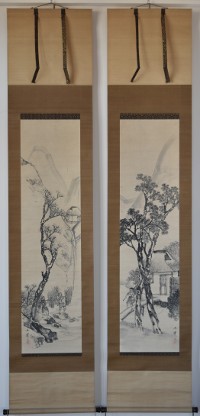
Click here to view image full size.
A pair of paintings, shosha and gyosha, a wood-chopper and fisherman in a mountainous landscape. Sumi on paper, image size 42.25 x 10.9 in; 108.3 x 27.7 cms. A highly talented Shijo painter and haiku poet who studied under Kishi Ganku and was much influenced by Chinese painting before developing his own individual style. Illustrated numerous ehon including Bumpo gafu, vols 1-3, 1807-13 (see following item); Kaido kyoka awase, 1811; Bumpo sansui gafu, 1824. Minor flaws but generally good condition. Each signed Bumpo with Nanzanju seal.
Status: Sold
Kawamura BUMPO (1779-1821) and Watanabe NANGAKU (1763-1813)
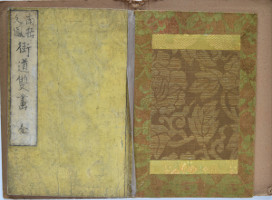
Click here to view image full size.
One volume complete Kaido kyoka awase, “Comparison of Kyoka Poems on the Highway.” Three pages preface signed Bumpo and thirty-six double-page illustrations alternating by Nangaku and Bumpo; last page colophon dated Bunka 8 (1811) with artists Nangaku Tseki and Bumpo Basei. Publishers Kawachiya Kihei, Osaka, and Yoshidaya Shimbei, Kyoto. Original embossed yellow covers with original title slip. Originally published in two volumes with the poems in volume one and almost immediately reissued as a one volume work, as here. Numerous collectors’ seals: Tanido Kyohitsu, Seiyo Kosetsu, and Edmond de Goncourt with his brocade binding and imitation wood slipcase. A beautiful example of this fine Shijo book in very good condition.
Status: Sold
Kawamura BUMPO (1779-1821)
Click here to view image full size.
One volume complete Kimpaen gafu “A Book of Paintings by Kimpaen [ Bumpo ].” Published Bunsei 3, 1820, by Hishiya Magobei. Bumpo’s major book of kacho-e. The better impressions ( as here ) do best justice to what Jack Hillier called the “boneless” technique ( without outline ).
Original covers with an indented mushroom design and title slip. Minor thumbing and other minor marks, otherwise very good condition.
Status: Sold
Kishi RENZAN (1805-1859)
Click here to view image full size.
An original painting by Renzan, also known as Gantoku. He was adopted by the Kishi family and trained by his father-in-law, Kishi Ganku, who founded the Kishi school. His fellow pupils were Yokoyama Kazan and Minwa Bumpo. After Ganku’s death, he became the leader of the school together with Gantai. Highly regarded in Japan, he painted the walls of the Room of the Wild Geese in the Kyoto Imperial Palace. Shows a fierce tiger, very much in the style of Ganku. This subject is usually found as a diptych with a dragon. But this painting seems to stand alone and was probably painted for a year of the tiger, 1842 (?). Sumi and light colour on silk. 37 x 14 in.; 94 x 35.5 cms. Interestingly, Renzan designed a surimono of this subject also for a Tiger year, 1842 or 1854.
Signed Kishi Bunshin with upper seal Kishi Bunshin and lower seal unread. In good condition although mount somewhat creased.
Status: Sold
Utagawa KUNISADA (1786-1865)
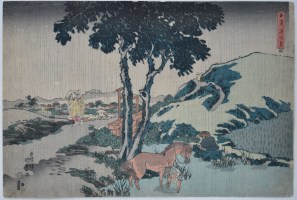
Click here to view image full size.
Samidare no kei, “Summer Rain” from an untitled set of eight landscapes published by Kinkodo c. 1832. Shows a man washing a horse in light rain. A group of pilgrims appear over a hill to the left. Part of the scene is based on an illustration from Kawamura Bumpo’s Bumpo sansui gafu of 1824. There are various states of this print. This is the earliest and most successful with the rain printed in green (not black) and the rain splashing in the river bottom right is blind-printed, not inked-in. Rare.
Fine impression and colour. Imperceptible centre fold, otherwise very good condition. Full size. Signed Kochoro Kunisada ga.
Status: Sold
Utagawa KUNIYOSHI (1797-1861)
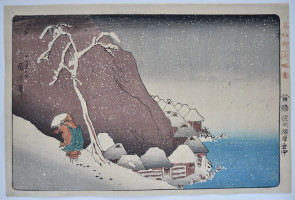
Click here to view image full size.
A snow scene showing Nichiren struggling up a snow-covered mountain near Tsukahara on the Island of Sado. The best design from Koso goichidai ryakuza, the “Illustrated Abridged Biography of the Founder.” Nichiren being the founder of the Buddhist Nichiren sect (Nichiren shu – Kuniyoshi being a follower) and indeed the set of ten prints may have been commissioned to mark the 550th anniversary of his death. Published by Iseya Rihei, c. 1831. Like many great landscapes, there exist different states which causes confusion over which is the earliest. The version offered here has the mountain printed in brown. Other impressions keep the mountain white. The other basic difference is that the design is known with and without a horizon line and that there is at least one impression where the un-inked, blind-printed line can be seen in a raked light. It has been asserted that those impressions without are the earliest; however, it seems from this that the sumi block was probably cut initially with the line but the publishers thought that it looked aesthetically better without printing it, and it was subsequently removed. In any case, this is a rare print and most surviving examples appear to be similar in impression. There is a break in the border to the left of the bottom of Kuniyoshi’s signature which could give a guide to the earliest states, but as this is often painted in, it is not reliable. The composition is based on a design in the illustrated book Bumpo sansui gafu by Kawamura Bumpo, published posthumously in 1824.
Very good impression, colour and condition with splashed gofun. Signed Ichiyusai Kuniyoshi hitsu.
Status: Sold
Utagawa KUNIYOSHI (1797-1861)
Click here to view image full size.
Nichiren struggling up a snow-covered mountain near Tsukahara on the Island of Sado. The best design from Koso goichidai ryakuza, the “Illustrated Abridged Biography of the Founder.” Nichiren being the founder of the Buddhist Nichiren sect ( Nichiren shu – Kuniyoshi being a follower ) and indeed the set of ten prints may have been commissioned to mark the 550th anniversary of his death. Published by Iseya Rihei, c 1831. Like many great landscapes, there exist different states which causes confusion over which is the earliest. The basic difference is that the design is known with and without a horizon line and that there is at least one impression where the uninked, blind-printed line can be seen in a raked light (as indeed it can on this impression). It has been asserted that those impressions without are the earliest; however, it seems from this that the sumi block was probably cut initially with the line but the publishers thought that it looked aesthetically better without printing it, and it was subsequently removed. In any case, this is an extremely rare print and most surviving examples appear to be similar in impression. There is a break in the border to the left of the bottom of Kuniyoshi’s signature which could give a guide to the earliest states, but as this is often painted in, it is not reliable. The composition is based on a design in the illustrated book Bumpo sansui gafu by Kawamura Bumpo, published posthumously in 1824. Although not from a landscape set, this is considered one of the great 19th century landscapes.
Fine impression and colour. Beautiful gradation with splashed gofun (oxidised). Slight centre fold, otherwise very good condition. Signed Ichiyusai Kuniyoshi hitsu.
Status: Sold
Utagawa KUNIYOSHI (1797-1861)
Click here to view image full size.
Nichiren struggling up a snow-covered mountain near Tsukahara on the Island of Sado. The best design from Koso goichidai ryakuza, the “Illustrated Abridged Biography of the Founder.” Nichiren being the founder of the Buddhist Nichiren sect ( Nichiren shu – Kuniyoshi being a follower ) and indeed the set of ten prints may have been commissioned to mark the 550th anniversary of his death. Published by Iseya Rihei, c 1831. Like many great landscapes, there exist different states which causes confusion over which is the earliest. The basic difference is that the design is known with and without a horizon line and that there is at least one impression where the uninked, blind-printed line can be seen in a raked light. It has been asserted that those impressions without are the earliest; however, it seems from this that the sumi block was probably cut initially with the line but the publishers thought that it looked aesthetically better without printing it, and it was subsequently removed. In any case, this is an extremely rare print and most surviving examples appear to be similar in impression. There is a break in the border to the left of the bottom of Kuniyoshi’s signature which could give a guide to the earliest states, but as this is often painted in, it is not reliable. The print offered here has the horizon line and the gradation at the base of the mountain upwards. Left border line is unbroken. The composition is based on a design in the illustrated book Bumpo sansui gafu by Kawamura Bumpo, published posthumously in 1824. Although not from a landscape set, this is considered one of the great 19th century landscapes. Provenance: Ex collection Hans Crzellitzer, seal top right corner.
Very good impression. Some fading and light soil. Slight centre fold. Signed Ichiyusai Kuniyoshi hitsu.
Status: Sold
Artists
( A to Z )
Kyogado ASHIKUNI ( Fl. c. 1807 – 1818 )
Gigado ASHIYUKI ( Fl. c. 1814 – 1833 )
Ki BAITEI ( 1734 – 1810 )
Takizawa BAKIN ( 1767 – 1848 )
Ono BAKUFU ( 1888 – 1976 )
Georges BIGOT ( 1860 – 1927 )
Kawamura BUMPO ( 1779 – 1821 )
Ippitsusai BUNCHO ( Fl. c. 1765 – 1792 )
Toyohara CHIKANOBU ( 1838 – 1912 )
Kishi CHIKUDO ( 1826 – 1897 )
Tsubaki CHINZAN ( 1801 – 1854 )
Eishosai CHOKI ( Fl. c. 1756 – 1808 ). See also SHIKO
Rekisentei EIRI ( Fl. c. 1790 – 1800 )
Keisai EISEN ( 1790 – 1848 )
Hosoda EISHI ( 1756 – 1829 )
Hosoda EISHO ( Fl. c. 1780 – 1800 )
Ichirakutei EISUI ( Fl. c. 1790 – 1823 )
Kikugawa EIZAN ( 1787 – 1867 )
Hirano HAKUHO ( 1879 – 1957 )
Elizabeth KEITH ( 1887 – 1956 )
Imao KEINEN ( 1845 – 1924 )
Yashima GAKUTEI ( 1786 – 1868 )
Ogata GEKKO ( 1859 – 1920 )
Adachi GINKO ( Fl. c. 1847 – 1897 )
Matsumura GOSHUN ( 1752 – 1811 )
GYOSAI. See Kawanabe KYOSAI
Hirano HAKUHO ( 1879 – 1957 )
Suzuki HARUNOBU ( 1724 – 1770 )
Kawase HASUI ( 1883 – 1957 )
Kitagawa HIDEMARO ( Fl. c. early 19th century )
Kinoshita HIRONOBU ( Fl. c. 1851 – 1870 )
Gosotei HIROSADA ( Fl. c. 1847 – 1863 )
Ichiryusai HIROSHIGE ( 1797 – 1858 )
Ichiryusai HIROSHIGE II ( 1826 – 1869 )
Ando HIROSHIGE III ( 1843 – 1894 )
Nakamura HOCHU ( Fl. c. late 18th to early 19th century )
Sakai HOITSU ( 1761 – 1828 )
Totoya HOKKEI ( 1780 – 1850 )
Teisai HOKUBA ( 1771 – 1844 )
Shunkosai HOKUEI (Active 1824-1837)
Katsushika HOKUGA ( Fl. c. 1830 )
Shotei HOKUJU ( Fl. c. 1789 – 1818 )
Katsushika HOKUSAI ( 1760 – 1849 ). Also used numerous other names such as: SORI, SHUNRO, SHINSAI
Shokosai HOKUSHU ( Fl. c. 1808 – 1832 )
KEISAI. See Kitao MASAYOSHI
Suzuki KIITSU ( 1796 – 1858 )
Kitagawa KIKUMARO ( Fl. c. ? – 1830 ). See TSUKIMARO
Kobayashi KIYOCHIKA ( 1847 – 1915 )
Torii KIYOHIRO ( Fl. c. 1737 – 1771 )
Torii KIYOMASA ( Fl. c. 1700 – 1722 )
KIYOMINE. See Torii KIYOMITSU II
Torii KIYOMITSU ( 1735 – 1785 )
Torii KIYOMITSU II ( 1787 – 1868 ). See KIYOMINE
Torii KIYONAGA ( 1752 – 1815 )
Torii KIYONOBU ( 1664 – 1729 )
Torii KIYONOBU II ( 1706 – 1763 )
Torii KIYOTSUNE ( Fl. c. 1757 – 1779 )
Isoda KORYUSAI ( Fl. c. 1767 – 1788 )
Ohara KOSON ( 1877 – 1945 ). See SHOSON
Torii KOTONDO ( 1900 – 1976 )
Toyohara KUNICHIKA ( 1835 – 1900 )
Utagawa KUNIHIRO ( Fl. c. 1815 – 1843 )
Ichiunsai KUNIHISA ( 1832 – 1891 )
Utagawa KUNINAO ( 1793 – 1854 )
Utagawa KUNISADA ( 1786 – 1865 )
Utagawa KUNISADA II ( 1823 – 1880 )
Utagawa KUNISATO ( ? – 1858 )
Utagawa KUNITERU ( 1808 – 1876 )
KUNITERU. See Utagawa SADASHIGE
Utagawa KUNITERU II ( 1829 – 1874 )
Utagawa KUNIYASU ( 1794 – 1832 )
Ichiyusai KUNIYOSHI ( 1797 – 1861 )
Santo KYODEN. See Kitao MASANOBU
Kawanabe KYOSAI ( 1831 – 1889 ). See GYOSAI
Okumura MASANOBU ( 1686 – 1764 )
KitaoMASANOBU ( 1761 – 1816 ). See Santo KYODEN
Kitao MASAYOSHI ( 1764 – 1824 ). See KEISAI
Oishi MATORA ( 1794 – 1833 )
Hishikawa MORONOBU ( Fl. c. 1618 – 1694 )
Nishimura NANTEI ( 1775 – 1834 )
Utagawa NOBUKATSU ( Fl. c. 1830 – 1844 )
Watanabe NOBUKAZU ( Fl. c. late 19th century )
Hishikawa RYUKOKU ( Fl. c. 1808 – 1816 )
Jokei RYUKOSAI ( Fl. 1772 – 1816 )
Gokitei SADAFUSA ( Fl. c. 1825 – 1850 )
Hasegawa SADAHARU ( Fl. c. 1830 – 1844 )
Gokotei SADAKAGE ( Fl. c. 1818 – 1844 )
Utagawa SADAHIDE ( 1807 – 1873 )
Hasegawa SADANOBU ( 1809 – 1879 )
Utagawa SADASHIGE ( Fl. c. mid 19th century ). See KUNITERU
Gofutei SADATORA ( Fl. c. 1825 )
Yamaguchi SHIGEHARU ( 1803 – 1853 )
Kitao SHIGEMASA ( 1739 – 1820 )
Nishimura SHIGENAGA ( 1697 ? – 1756 )
Nishimura SHIGENOBU ( Fl. c. 1724 – 1735 )
SHIKO. See Eishosai CHOKI
Ryuryukyo SHINSAI ( 1764 – 1820 )
Ito SHINSUI ( 1898 – 1972 )
Kojima SHOGETSU ( Fl. c. 1880 – 1890 )
SHOSON. See Ohara KOSON
Takahashi SHOTEI ( 1871 – 1945 )
Yamamoto SHOUN ( 1870 – 1965 )
Yamakawa SHUHO ( 1898 – 1944 )
Katsukawa SHUNCHO ( Fl. c. 1780 – 1795 )
Takehara SHUNCHOSAI ( Fl. c. 1772 – 1801 )
Katsukawa SHUN’EI ( 1762 – 1819 )
Katsukawa SHUNKO ( 1743 – 1812 )
Hishikawa SHUNKYO ( Fl. c. early 19th century )
Kubo SHUNMAN ( 1757 – 1820 )
Katsukawa SHUNSEN ( Fl. c. 1762 – 1830 )
Natori SHUNSEN ( 1886 – 1960 )
Gatoken SHUNSHI ( Fl. c. 1820 – 1828 )
Katsukawa SHUNSHO ( 1726 – 1792 )
Katsukawa SHUNTEI ( 1770 – 1820 )
Katsukawa SHUNZAN ( Fl. c. 1782 – 1798 )
Yamaguchi SOKEN ( 1759 – 1834 )
Ikeno TAIGA ( 1723 – 1776 )
Katsukawa TERUSHIGE ( Fl. c. 1715 – 1725 )
Mori TETSUZAN (1775-1841)
Migita TOSHIHIDE ( 1863 – 1925 )
Mizuno TOSHIKATA ( 1866 – 1908 )
Okumura TOSHINOBU ( Fl. c. 1717 – 1750 )
Utagawa TOYOHARU ( 1735 – 1814 )
Utagawa TOYOHIRO ( 1773 – 1828 )
Utagawa TOYOKUNI ( 1769 – 1825 )
Utagawa TOYOKUNI II ( 1777 – 1835 ). See TOYOSHIGE
Yamamura TOYONARI ( 1885 – 1942 )
Ishikawa TOYONOBU ( 1711 – 1785 )
TOYOSHIGE. See Utagawa TOYOKUNI II
TSUKIMARO. See Kitagawa KIKUMARO
Kitano TSUNETOMI ( 1880 – 1947 )
Toyokawa UMEKUNI ( Fl. c. 1816 – 1826 )
Kitagawa UTAMARO ( 1753 – 1806 )
Kitagawa UTAMARO II ( ? – 1831 )
Inoue YASUJI ( 1864 – 1889 )
Hiroshi YOSHIDA ( 1876 – 1950 )
Ipposai YOSHIFUJI ( 1828 – 1887 )
Utagawa YOSHIIKU ( 1833 – 1904 )
Utagawa YOSHIKATA ( Fl. c. 1841 – 1864 )
Utagawa YOSHIKAZU ( Fl. c. 1850 – 1870 )
Toyokawa YOSHIKUNI ( Fl. c. 1803 – 1840 )
Utagawa YOSHIMUNE ( 1817 – 1880 )
Ichiyosai YOSHITAKI ( 1841 – 1899 )
Utagawa YOSHITORA ( Fl. c. 1850 – 1880 )
Taiso YOSHITOSHI ( 1839 – 1892 )
Utagawa YOSHITSURU ( Fl. c. 1840 – 1850 )
Ichieisai YOSHITSUYA ( 1822 – 1866 )
Mori YOSHIYUKI ( 1835 – 1879 )
Shibata ZESHIN ( 1807 – 1891 )
